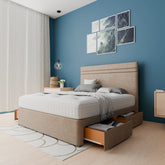Have you ever felt more exhausted in the morning than at night? No matter how many pillows you use or how you position yourself at night, those nagging pains may still be bothering you. Many of us suffer from sleep discomfort at night, which impacts overall health.
Sometimes, the culprit behind these sleep woes often lies in our choice of mattress.
We understand finding the perfect mattress is confusing when the market is saturated with many options. Amongst these, orthopaedic and memory foam mattresses are two popular options, each claiming to provide the comfort you need for a good night’s sleep. But how do you know which one is best for you? Our guide will help you make the right choice for a healthier, more restful night's sleep by providing the following insights:
- What is an Orthopaedic Mattress?
- Advantages of having an Orthopaedic mattress
- Disadvantages of Orthopaedic mattress
- What is a Memory Foam Mattress?
- Are Memory Foam Mattresses Good?
- Downsides of Memory Foam Mattress
- Orthopedic Vs Memory Foam Mattress: Which One To Choose
- Final Remarks
What is an Orthopaedic Mattress?
This mattress is made to benefit people with musculoskeletal problems, such as back pain, joint discomfort, or other orthopaedic issues. Orthopaedic mattresses are usually constructed with memory foam, innerspring coil systems, and high-density foam.
While innerspring coils provide durability and even weight distribution, high-density foam gives firm support. In addition, memory foam relieves pressure points by conforming to your body's shape. As you sleep, these elements work as a team to support healthy spinal alignment and lower musculoskeletal aches.
Advantages of Having an Orthopaedic Mattress
Do you find it difficult to get a good night's sleep and often turn and toss? You may need a mattress that responds to your body's requirements and prevents sleep disturbances. Let us examine how an orthopaedic mattress can benefit you:
Gives Best Spinal Support
Orthopaedic mattresses are made to give excellent spinal support, maintain their natural curve, and reduce the risk of chronic back pain. If you sleep with a healthy spinal curve, you can wake up without backaches.
Reduce Pressure Points
The next medical quality of an orthopaedic mattress is its pain point relief. Its firmer sleeping surface relieves the pressure points, distributes your body weight evenly and ensures a restorative sleep. Thus, you don't have to battle all night to find a comfortable posture.
Durability
Thanks to density foam and innerspring coils, orthopaedic mattresses are made for longevity. So, you don’t have to worry about lumpy or sagging areas anytime soon.
Promotes Better Blood Circulation
As orthopaedic mattresses support the muscles and joints, the chance of feeling cramped gets reduced. So, it can also benefit your cardiovascular health and maintain a healthy blood flow.
Versatility
Whether you prefer memory foam or inner springs, orthopaedic mattresses come in various options. Thus, it allows you to choose one that meets your sleeping needs.
Ideal for Couples
If you get disturbed by the tossing of your partner’s movements at night, opting for an orthopaedic mattress is suitable. Its feature of less motion transfer can ensure a restful sleep.
Disadvantages of Orthopedic Mattress
Although orthopaedic mattresses can be a good fit for their various qualities, there are also some downsides that you need to consider before investing in an orthopaedic mattress:
Firmness is Not For Everyone
Although orthopaedic mattresses are known for their firm support, they may not be preferable for people who want a softer sleeping surface. So, they can be too hard for some individuals.
Pricey
If you’re on a tight budget, the price of an orthopaedic mattress may limit you. Due to the materials involved in its build, this mattress can be more expensive than other types.
Not Ideal For Side Sleepers
The orthopaedic mattress is often recommended for back sleepers. The stiffness can cause pressure points on the shoulders and hips, so they might not be as relaxing for side sleepers.
Difficult to Move or Rotate
This mattress is heavier than other types because of its construction. Thus, to maintain its even wear and tear, you might face difficulty rotating it.
What is a Memory Foam Mattress?
Memory foam is also known as viscoelastic foam, a material that contours the shape of your body by using your body and heat and pressure. It’s fun to know that this foam takes the name ‘memory’ because it slowly bounces back to its original position and memorises your sleeping position and body shape over time.
This type of foam originated in the 1960s by NASA astronauts to resist extreme pressure while entering or exiting from the Earth. Since then, memory foam has become widely popular in mattresses, pillows and other products.
What are Some Types of Memory Foam?
Memory foam is made in different types and combinations of materials for personalised sleeping comfort. Let’s have a look at some common types:
Open-Cell Memory Foam
As the name indicates, this type of memory foam is porous, with interconnected air pockets to promote better air circulation. As memory foam is associated with heat buildup, this design helps dissipate extra heat and leads to a cooler sleeping experience. Besides other features, it retains the ability to contour to your body shape.
Traditional Memory Foam
It can contour to your body shape when exposed to the body’s pressure and heat. It reduces pressure points and gives a supportive sleeping surface. But it can be uncomfortable for hot sleepers, as it does not dissipate extra heat.
Gel Memory Foam
This type of mattress infuses gel beads into the traditional foam’s composition. It aims to regulate temperature and rectify the issue of trapping heat. Gel memory foam has the same contouring and supporting qualities as regular memory foam, but it is made to be cooler to sleep on.
Are Memory Foam Mattresses Good?
A memory foam mattress is usually a popular choice among many folks, but you can only call it ‘good’ if it suits your sleeping needs. Here are some features that you need to ponder to check if a memory foam mattress is a good candidate:
Personalised Comfort & Support
The ability of memory to adapt your body shape lets you enjoy comfort according to your sleeping needs. Also, it is supportive enough to provide a comfortable sleeping surface.
Motion Transfer
Memory foam is best for reducing motion transfer. It reduces the disturbances from your partner's movements, which makes it an excellent choice for couples sharing a bed.
Pain Alleviation
If you're experiencing joint or back pain, memory foam can reduce it because it adapts to your body's shape.
Longevity
As it is built with durable materials, memory foam can be a useful investment.
Also Read: Which Mattress Is Best For Back Pain?
Downsides of Memory Foam Mattress
While memory foam offers many perks, there are also some downsides that you need to consider before choosing it. Let’s spotlight some:
Heat Retention
If you're a hot sleeper, a memory foam mattress can be uncomfortable because it traps heat. However, if you opt for a gel-infused or open-cell memory foam mattress, you can resolve this problem.
Initial Odour
If you first unpack a memory foam mattress, it may emit a temporary chemical smell. But it goes away within a few days.
Firmness Level
You can find memory foam mattresses too soft or too stiff according to your sleeping preferences; the stiffness of the mattresses can vary in some models. So, make sure to check the firmness level before buying.
Costly
High-quality memory foam mattresses can be expensive, and not everyone can afford them.
Orthopedic Vs Memory Foam Mattress: How To Choose?
Since you have explored the features and downsides of both mattresses, it’s time to compare both and let you decide which one is suitable for you:
| Features | Orthopedic Mattress | Memory Foam Mattress |
|---|---|---|
| Firmness | Typically firm | Varied options, from soft to Firm |
| Support | Firm and Even Support for the spine and joints and relieves back pain. | Adapts to body shape for pressure point relief. |
| Motion Isolation | Typically good at isolating motion, making it suitable for couples. | Provides minimal motion transfer |
| Sleep Preferences | Ideal for back sleepers and those seeking firm support | Suitable for various sleep positions and preferences |
| Heat Retention | May sleep cooler with proper airflow. | It can retain heat, but some models have cooling features. |
| Durability | Generally durable | Durable and long-lasting |
Final Remarks
Choosing between an orthopaedic mattress and a memory foam mattress is the main decision to ensure a restful night’s sleep. Each has a different set of benefits and things to think about. Because orthopaedic mattresses are so good at supporting firmness, they're great for anyone with back and joint issues.
Conversely, memory foam mattresses provide individualised comfort by conforming to the contours of your body. Your particular needs will determine your choice of mattress, whether you value pressure relief, a cooler sleeping surface, or spine alignment.






